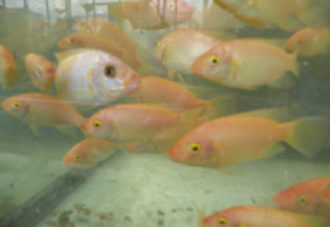Aquaponics has been defined as the combined culture of fish and plants in recirculating systems. Some of the benefits of commercial aquaponics production systems compared to typical agricultural production include reduced water use, reduced land footprint, reduced energy use, increased yields, and improved traceability. Aquaponics systems are also versatile, meaning that they can be tailored to meet a farmer’s specific climate and environment. For example, the heavily researched commercial aquaponics system developed at the University of the Virgin Islands is built in an open field, and only requires bird netting to cover the aquaculture components of the system. However, someone living in a less tropical climate could build the UVI system under a greenhouse, or inside of some other building or structure. This would allow a farmer to use supplemental heating during colder months of the year, and to use climate control throughout the entire year of production if necessary.
Despite the production possibilities, the economics of commercial aquaponics systems have not been heavily researched. Can commercial aquaponics systems be truly economically viable, and can revenue generated from selling food and agricultural products grown in a commercial aquaponics system support a farmer and his/her family? Would aquaponics systems be economically viable if their structures or configurations were altered to perform better in different types of climates? After all, a true commercial aquaponics producer is really a farmer, in every sense of the word, and farms must enable their caretakers to make a living through what they can produce.
To answer those questions, the following case studies developed by University of Kentucky showcase three commercial aquaponics systems in Texas, Florida and the U.S. Virgin Islands.
An economic analysis of each system found that each one of the commercial aquaponics systems researched presents an economically viable option for potential commercial aquaponics producers. Each one of these commercial aquaponics systems can be economically viable within the United States. The revenue generated solely from selling food and agricultural products grown in these commercial aquaponics systems could support a farmer and their family. Each system also generates enough profit to pay the farmer and their family, and to reinvest funds back into the business. The structures and configurations of these aquaponics systems could also be altered to perform better in different types of climates.
This information collected is intended to provide some guidance for the commercial aquaponics industry and potential producers, as well as assist with designing a system or a business plan for commercial aquaponics production systems.
Case Study No:1: Lily Pad Farms -- Lily Pad Farm is a commercial aquaponics farm in Texas that consists of three independently built commercial aquaponics systems that are each housed in their own greenhouse. The owners, Adam and Susan Harwood, live and work on this small family farm of just over two acres in size. Each of the three commercial aquaponics systems on this farm are smaller scale, altered versions of the University of Virgin Islands system. They each have two shorter, wider hydroponic raceways and fewer, larger rearing tanks with higher stocking densities than the UVI system. These systems are also built inside of greenhouses that require supplemental heating during some months of the year. The proprietors have faced some of the hardships typical to traditional farmers in the past few years of their operations, such as a total fish kill and a total crop loss, but their systems have literally and figuratively weathered the storms.
Case Study No. 2: Traders Hill Farm -- Traders Hill Farms is a commercial aquaponics farm located on the over 100 acre property of the Blaudow family. Angela TenBroeck is the Manager of Operations at Traders Hill Farms, and is the inspiration behind the family farm’s pursuit of commercial aquaponics. This farm still has two former commercial hen houses located on it, and the original commercial aquaponics system is built inside of one of those old hen houses. This system is fairly similar to the UVI system, but it has slightly smaller fish rearing tanks and only three hydroponic raceways. This system is also configured a bit differently, and has been looped into other aquaponics production systems for the purposes of product testing and production system performance analysis. Traders Hill Farms has also faced a fairly steep learning curve and some traditional farming hardships. However, they have recently been able to dramatically increase production, and are currently in the process of building a new commercial aquaponics system.
Case Study No. 3: University of Virgin Islands -- The Agricultural Experiment Station at the University of the Virgin Islands is still home to the original commercial aquaponics system developed at UVI. This aquaponics system sits in an open field with its hydroponic beds uncovered. Only the aquaculture components of the UVI system are covered by bird netting. The UVI system set the foundation for the other commercial aquaponics systems that were researched during this project. However, each system varies in multiple ways, including in regards to their system configurations, components, production figures, annual sales revenue, and much more.
Want more information? See the related SARE grant:
This material is based upon work that is supported by the National Institute of Food and Agriculture, U.S. Department of Agriculture through the Sustainable Agriculture Research and Education (SARE) program. Any opinions, findings, conclusions, or recommendations expressed in this publication are those of the author(s) and do not necessarily reflect the view of the U.S. Department of Agriculture or SARE.
